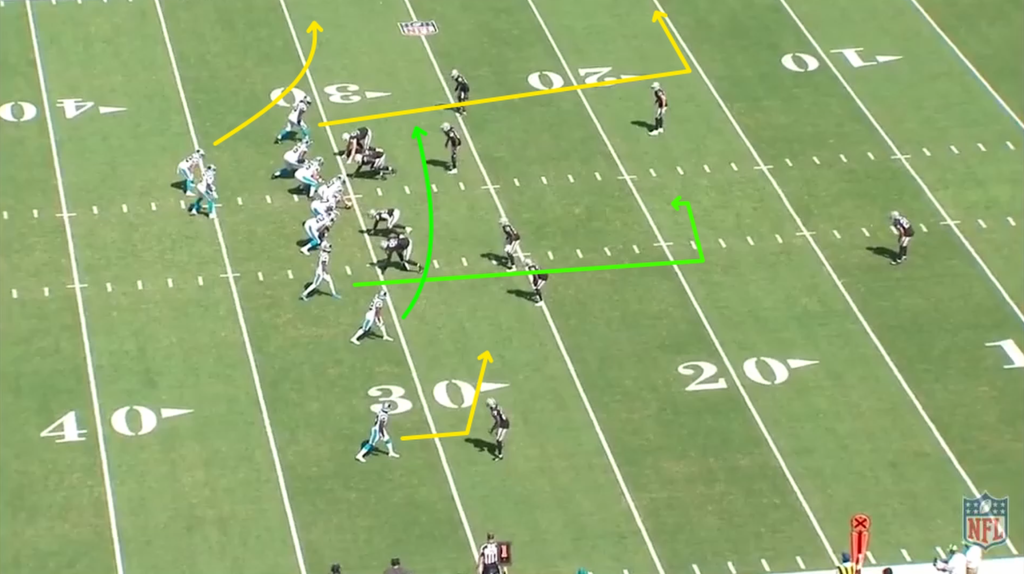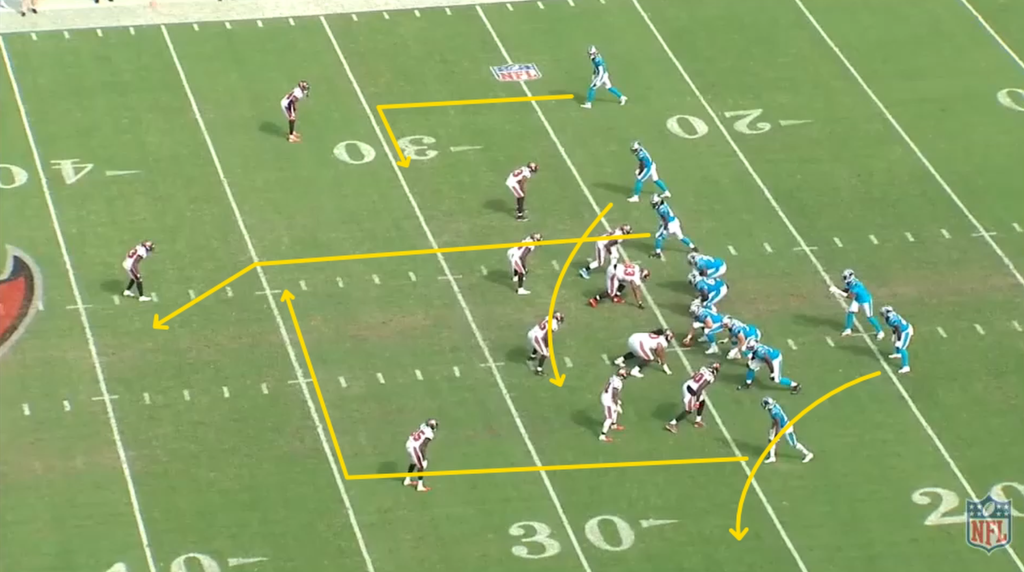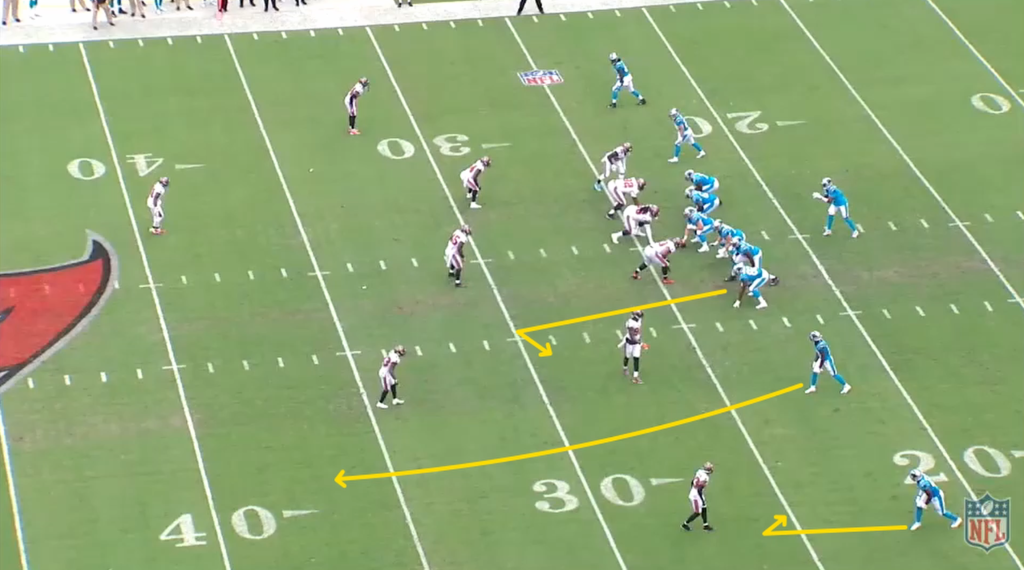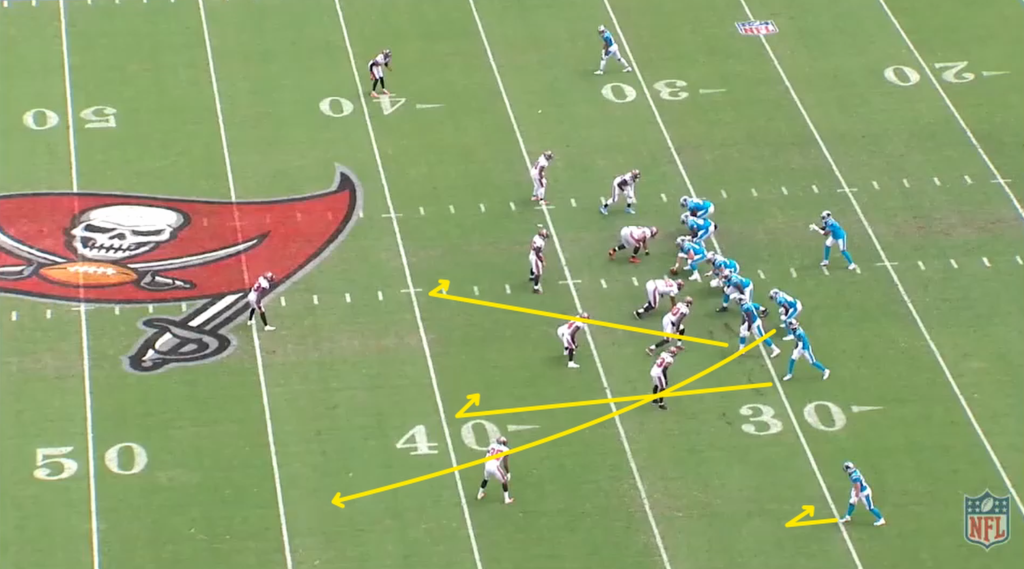
Let’s start out with his use of the Shallow Cross concept which is used at almost every level of football. In Carolina, though he’s got some cool little wrinkles and ways to get into the concept. Joe Brady absolutely loves to run trips to the field and put his running back into the boundary to open up space in the middle of the field.
For all intents and purposes, immediately releasing your running back is really like running an empty formation. What that does is remove linebackers from the middle of the field and space out defenses.
And if you’re going to be attacking horizontally and running these spread concepts it really puts the defense in a tough spot because you’re essentially flooding each zone with a route and creating one-on-one matchups across the field with receivers on linebackers.


Shallow Cross is essentially just a high low concept in the middle of the field. You have one shallow drag coming across the field and then one deep dig or dig sit at 10-12 yards coming behind it.
Normally though, if you don’t release your running back, the boundary side linebacker will pick up the drag and the field side linebacker can get underneath your dig. But with the running back releasing, that automatically pulls the boundary linebacker into the flats and clears space in the middle of the field.
So now that field side linebacker is left to defend a ton of space by himself. He has to pick either the shallow or the dig. Since Joe Brady is running spread, that really targets the two linebackers in the middle of the field. What Brady does that’s a small wrinkle is that he has a switch call on the shallow and the dig.
Usually they’re run either opposite each other or in sequence with the shallow from the #3 receiver and then the dig from the #2 receiver. But here, Brady flips that. And what that does is give the dig leverage on the corner that is splitting the difference between the #3 and #2 and also allows time for the running back to release and pull that boundary linebacker before the drag comes in behind him.
As we see here, the linebacker stays shallow, the dig is able to get inside leverage, and there’s a huge amount of space in the middle of the field to attack.


One way that Joe Brady dresses the concept up is with a short motion from the outside receiver to get them momentum headed into the shallow drag. Again, though, it’s trips to the field with the running back flaring into the boundary. You can see the boundary side outside linebacker again fly with the running back and open up space underneath.
The #3 receiver has inside leverage for his dig and does a really good job of pushing vertically at the will linebacker in the middle of the field to make him turn his hips away from the shallow drag. This clears a ton of space underneath for an easy completion to Robby Anderson who then can work upfield and use the open space.

Another way to run shallow cross is by running the dig from the opposite side of the field. The same principles still apply though. The running back takes a linebacker out of the box and if he is out leveraged or is caught on a run read, it’s an easy throw to the running back.
On the shallow drag side, you’ve now cleared space underneath and you can high low the remaining middle field linebacker. If he comes under the dig, you can throw the drag, if he stays to pick up the drag, there’s a window to the dig. Joe Brady is all about getting his playmakers in space and using their speed and that speed doesn’t have to kill you vertically – you can also run away from people horizontally.
Shallow Cross works vs. zone and man coverage since the zones are strapped by the clear outs from the running back and the light box because of the spread formations. The Panthers then have the speed to run away from people in man.


Here’s one last illustration of the Shallow Cross concept now because the Panthers have something built in for man and for defenses taking away those crossers in the middle of the field. Carolina runs the same short motion with the same concept, but now you see the corner run with the motion in man coverage.
The linebacker is now more attentive to the dig and collisions him on his way to picking up the drag underneath. But what this now does is it flows everyone to that side which opens up space backside for a quick slant from Curtis Samuel. The flow of the defense all goes to the boundary and Samuel is able to easily win his route with a quick outside stem and there’s a ton of space for him to catch the ball and get vertical with his speed.

You can see that same coverage and concept here from the Cardinals as they’re running a match coverage to the bottom of the screen but have a lock call on Robby Anderson at the top. They cover the running back and drag well and the safety is cheating down to jump the dig here because the Panthers have run it so much in the past.
Where Teddy should go is the backside slant coming in behind that shallow drag. Instead, he’s lucky that the ball was tipped at the line of scrimmage because it looks like it would have been an easy interception if he managed to get the ball off to the dig route.

Joe Brady loves to use speed and horizontal spacing and a great way to attack that in true spread form is through empty formations. Spread the defense out and make them defend every blade of grass. It stresses your protection plan, but can also make any blitzes pretty vanilla unless you’re really willing to open yourself up to being beat on a big play as a defense.
With quick reads like the Stick concept, that eliminates some of that issue. The Stick concept at it’s core is just someone in the flats, someone vertical, and then the stick from the #3 receiver.
It widens flat defenders outside, removes vertical defenders, and leaves space in the hook flat area to be attacked. Typically you’ll see a fade on the outside, a 5 yard speed out from the #2, and the stick from #3, but Joe Brady runs it a little different. He will often use a quick hook from the #1, a slot fade from #2, and the stick from #3. He gets to the same concept, just in a different way. The Bucs here are in cover 6 – cover 4 to the field and cover 2 to the boundary.
So the flat defender to the field is the outside linebacker who’s put in an impossible spot with the stick concept. Teddy reads the flat defender and as soon as he widens to the quick hitch outside, he knows he’s throwing the stick. The defense is just stretched too wide horizontally and it’s an easy completion.


While to the trips side, they usually work the stick concept a lot, to the backside they’re usually running an option route and they almost always like putting their running back out there who ends up matched up on a linebacker. All he’s doing is working up onto the linebacker and running an out or slant based on their leverage.
If the defender is leveraged inside, he’ll break it off on an out. You can see here how Christian McCaffrey is working upfield while looking directly at the linebacker lined up over him. He’s reading his leverage. The linebacker walls off inside, so McCaffrey cuts flat outside and it’s an easy completion.


This time it’s a receiver, but if that defender’s hips stay square or he doesn’t wall off, the option route is going to cut inside on a slant which is just what happens here. If the DB plays patient, the receiver dictates the tempo and attacks the vacated space in the middle of the field as linebackers flow to the stick concept and are spread out due to the empty formation.

If you look back at our original stick play and check out the backside, you can see McCaffrey do the same thing as Robby Anderson and cut inside on a slant with the linebacker keeping his hips square to the line of scrimmage and not walling off the inside.

While Stick can be incredibly effective against zone, Joe Brady’s version can struggle against man since the normal out route is replaced by that quick hook from the outside receiver. So there’s nobody running away from defenders and creating space – except for that slot fade vertical from the #2.
So if the Panthers see man coverage versus their stick concept, they’ll throw the slot fade. It gives the receiver more space to work with and the quick hitch outside keeps the outside corner from dropping underneath it and making a play. They don’t connect here because Bridgewater leaves the ball too far inside, but the play is there.

The Panthers have also run the Stick concept out of a Quads look. You have all the same principles, a vertical, a player in the flats, and a stick route working off the linebacker. They just get to it in a different way. With the tight Ace bunch, it pulls defenders close to the line of scrimmage and delays the defender responsible for the flats from getting out to the quick hook.
In this case, the flat defender is the nickel to the outside of that tight formation. He now has three separate routes he has to digest before going to the flats and also needs to carry vertical seams to be able to help protect the safety. So, with a vertical release from the H and the two stick routes by the other receivers in the bunch, the defense has nobody to get out to the flats.
That leaves maybe the Panthers’ best player Christian McCaffrey out on the perimeter with space to work with on a 3rd and short situation. It’s an easy read for the QB and a nice pickup for a first down.


The Panthers, Matt Rhule, and Joe Brady may be flying under the radar a little bit right now with the Saints and Bucs taking a lot of the headlines in the NFC South, but they’re quietly right in the thick of things in that division at 2-2 and right now they’re ranked 8th in passing yardage.
Joe Brady has a diverse playbook but he loves to use spread concepts that really stress defenses and attack every blade of grass. He has meshed the use of the Panthers speed and dynamic playmakers perfectly for his style of offense. He has a quarterback that struggles to throw deep at times but is accurate underneath and he’s put some twists and variations on tried and true schemes with spread formations.
Not much talk was made of the Panthers being competitors but there is no doubt in my mind that if they aren’t this season – they soon will be. Joe Brady is dissecting defenses and forcing them to cover horizontally and then chase down speedy playmakers.
The Panthers are coming. They’re going to attack the whole field, use their speed on linebackers, and if defenses aren’t fast enough or athletic enough to keep up with the dynamic backs and receivers of the Panthers, they’re going to make you pay.
If you liked this post make sure to subscribe below and let us know what you think. If you feel like donating and want access to some early blog releases and exclusive breakdown content or to help us keep things running, you can visit our Patreon page here. Make sure to follow us on Instagram @weekly_spiral and twitter @weeklyspiral for updates when we post and release our podcasts. You can find the Weekly Spiral podcast on Spotify or anywhere you listen.






